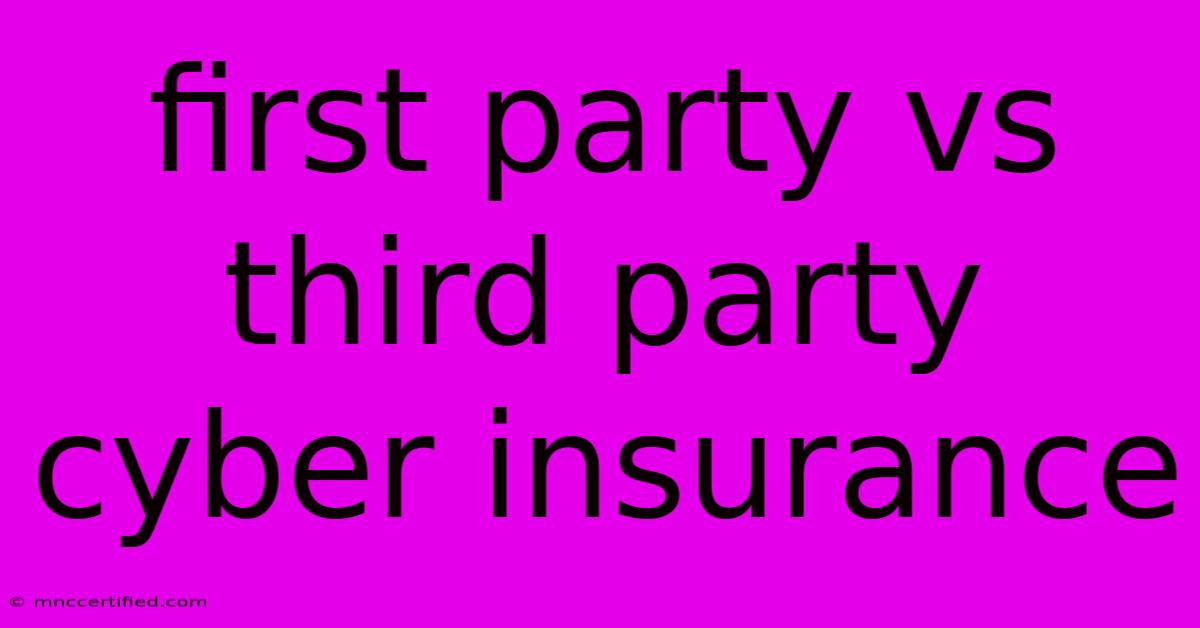First Party Vs Third Party Cyber Insurance

Table of Contents
First-Party vs. Third-Party Cyber Insurance: Understanding Your Coverage Needs
In today's digital age, cyber threats are more prevalent than ever. From data breaches to ransomware attacks, the potential for financial and reputational damage is significant. That's why cyber insurance has become an essential part of risk management for businesses of all sizes.
But navigating the world of cyber insurance can be confusing, especially when it comes to understanding the difference between first-party and third-party coverage. This guide will break down the key distinctions, helping you choose the right insurance policy for your specific needs.
What is First-Party Cyber Insurance?
First-party cyber insurance focuses on covering your own losses resulting from a cyber incident. This type of coverage typically includes:
- Data breach expenses: Costs associated with notifying affected individuals, credit monitoring, and forensic investigations.
- Business interruption: Lost income and extra expenses incurred due to a cyberattack that disrupts your operations.
- Cyber extortion: Reimbursement for ransom payments if you are a victim of a ransomware attack.
- Data recovery: Costs of restoring lost or corrupted data.
- System recovery: Expenses related to rebuilding or replacing compromised systems.
What is Third-Party Cyber Insurance?
Third-party cyber insurance protects you from financial liability stemming from a cyber incident that damages another party. This type of coverage typically includes:
- Privacy liability: Protection against claims arising from unauthorized access to personal data.
- Cybersecurity liability: Coverage for claims arising from your company's negligent cybersecurity practices.
- Network security liability: Insurance for claims related to your network causing harm to others.
- Intellectual property infringement: Coverage for legal expenses related to claims of intellectual property theft or misuse.
When Do You Need First-Party Coverage?
First-party cyber insurance is crucial for any organization that relies heavily on digital data and systems. It helps mitigate the financial impact of:
- Data breaches: Protecting your business from the high costs associated with data breaches, including legal fees, regulatory fines, and customer notification.
- Ransomware attacks: Providing financial support in the event of a ransomware attack, which can disrupt your operations and lead to significant downtime.
- System failures: Covering the costs of recovering your systems and data after a cyberattack.
When Do You Need Third-Party Coverage?
Third-party cyber insurance is essential for organizations that:
- Handle sensitive personal data: Protecting you from lawsuits and fines if you are responsible for a data breach that exposes personal information.
- Provide online services or products: Safeguarding you against claims related to breaches of your website, software, or services.
- Operate in a highly regulated industry: Offering protection against compliance violations and penalties related to cybersecurity regulations.
Choosing the Right Coverage
The best cyber insurance policy will depend on your individual circumstances, including the size and type of your business, the data you handle, and your overall cybersecurity posture.
Here are some important factors to consider:
- Your risk profile: Assess your potential exposure to cyber threats and prioritize coverage based on your unique vulnerabilities.
- Your budget: Cyber insurance premiums can vary significantly based on factors like your coverage limits and your company's size.
- The policy's terms and conditions: Thoroughly review the policy details, including coverage limits, exclusions, and deductibles.
Key Considerations for Both First-Party and Third-Party Coverage
- Coverage limits: The maximum amount the insurance company will pay for a covered event.
- Deductibles: The amount you must pay out of pocket before your insurance coverage kicks in.
- Exclusions: Specific types of events or losses that are not covered by the policy.
- Cybersecurity requirements: Some insurance companies may require you to have certain cybersecurity measures in place to qualify for coverage.
In Conclusion
Understanding the difference between first-party and third-party cyber insurance is crucial for protecting your business against cyber threats. Both types of coverage play a vital role in mitigating risk and ensuring financial stability in the event of a cyberattack.
By carefully evaluating your needs and choosing the right policy, you can secure the necessary protection to safeguard your business from the growing threat of cybercrime.

Thank you for visiting our website wich cover about First Party Vs Third Party Cyber Insurance. We hope the information provided has been useful to you. Feel free to contact us if you have any questions or need further assistance. See you next time and dont miss to bookmark.
Featured Posts
-
Red Star Belgrade Vs Barcelona Who Will Win
Nov 07, 2024
-
Biden Breaks Silence On Trumps Win
Nov 07, 2024
-
Does Boat Insurance Cover Hurricane Damage
Nov 07, 2024
-
Bitcoin Soars Trump Win Fuels Crypto Rally
Nov 07, 2024
-
Elon Musk Trumps Legacy On His Companies
Nov 07, 2024